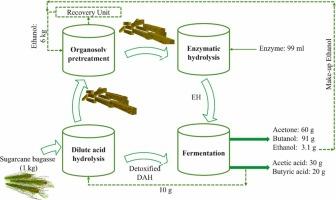蔗渣的可持续和高效增值:将综纤维素转化为丙酮、丁醇和乙醇
IF 6.2
1区 农林科学
Q1 AGRICULTURAL ENGINEERING
引用次数: 0
摘要
作为可发酵碳源的生物质的半纤维素部分通常在最常见的生物燃料生产过程中被丢弃,直接影响含半纤维素的木质纤维素的整体转化效率,如甘蔗甘蔗渣(SB)。本研究以乙酰丁酸梭菌为原料,开发了一种将SB的半纤维素和纤维素含量高效转化为丙酮、丁醇和乙醇(ABE)的综合工艺。该工艺包括稀酸水解、有机溶剂预处理、酶解和发酵。为了保证工艺的可持续性,本研究利用原发酵副产物(即乙酸和丁酸)作为酸化剂,对半纤维素进行稀酸水解,回收木糖。180℃木糖得率为22.3% %,显著高于150℃木糖得率7.6% %。此外,通过乙醇脱木质素得到纯化木质素作为副产物,其中稀酸水解步骤中残留在底物上的微量酸增强了脱木质素过程。混合解毒稀酸解液和酶解液发酵ABE产量显著增加,最佳情况下ABE产量从9.9 g/L提高到12.23 g/L。这一综合和可持续的过程为富含木糖的木质纤维素材料(如SB)的高效增值提供了一条有前途的途径。本文章由计算机程序翻译,如有差异,请以英文原文为准。

Sustainable and efficient valorization of sugarcane bagasse: Integrated conversion of holocellulose into acetone, butanol, and ethanol
The hemicellulose fraction of biomass as a fermentable carbon source is typically discarded in the most common biofuel production processes, directly impacting the overall conversion efficiency of hemicellulose-containing lignocelluloses, such as sugarcane bagasse (SB). In this study, an integrated process was developed to efficiently convert both the hemicellulose and cellulose content of SB into acetone, butanol, and ethanol (ABE), employing Clostridium acetobutylicum. The process comprised dilute acid hydrolysis, organosolv pretreatment, enzymatic hydrolysis, and fermentation. To ensure a sustainable process, the primary fermentation byproducts (i.e., acetic acid and butyric acid) were utilized as the acidic agents in the dilute acid hydrolysis of hemicellulose for xylose recovery. The amount of xylose obtained at 180 °C was 22.3 %, significantly higher than that at 150 °C, which was 7.6 %. Furthermore, purified lignin was obtained as a byproduct through ethanolic delignification, where trace acids remaining on the substrate from the dilute acid hydrolysis step enhance the delignification process. Fermentation of mixed detoxified dilute acid hydrolysate and enzymatic hydrolysate resulted in a significant increase in ABE production, elevating it from 9.9 to 12.23 g/L in the best case. This integrated and sustainable process suggests a promising approach for the efficient valorization of xylose-rich lignocellulosic materials such as SB.
求助全文
通过发布文献求助,成功后即可免费获取论文全文。
去求助
来源期刊

Industrial Crops and Products
农林科学-农业工程
CiteScore
9.50
自引率
8.50%
发文量
1518
审稿时长
43 days
期刊介绍:
Industrial Crops and Products is an International Journal publishing academic and industrial research on industrial (defined as non-food/non-feed) crops and products. Papers concern both crop-oriented and bio-based materials from crops-oriented research, and should be of interest to an international audience, hypothesis driven, and where comparisons are made statistics performed.
 求助内容:
求助内容: 应助结果提醒方式:
应助结果提醒方式:


